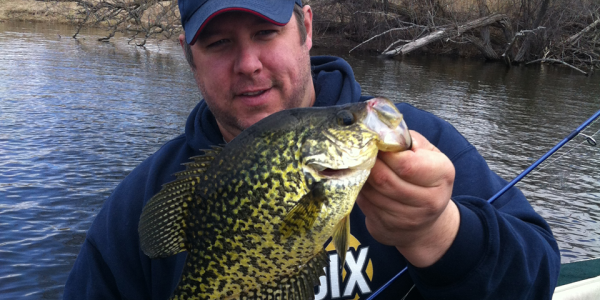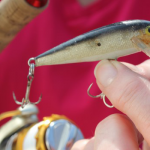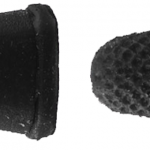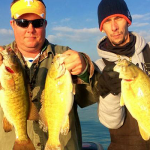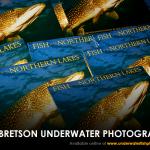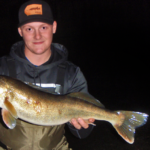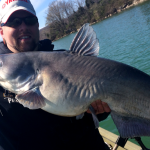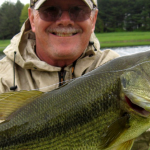By JP Bushey
Successful crappie hunting this time of season ‘up north’ is usually two scoops of an open mind with a pinch of simple presentations. Fish early on will use some oddball spots. Here’s a few to check.
Looking at the big picture, black crappie in Ontario’s north really aren’t that different from the ones swimming in a Texas reservoir, a glacial pothole in the Dakotas or a Florida backwater. Without fail, they’ll feed, move and spawn, every year. Where things kind of branch off up here, is with respect to early season locations. The reality is that crappie are highly adaptable, successful spawners and able to get a foothold no matter what type of system they’re found in. They’ve taken off in a wide range of lakes and rivers up here. In a lot of cases, crappie simply don’t have much of the ‘classic’ spring stuff to use. Some of the places we find them make good sense. Others are pretty off the wall. Fish are catchable in both.
Like you’ll find anywhere in crappie country, spring weather has the biggest impact on where these fish wind up, what they eat and what kind of attitude they have. Most places up here, ice-out ranges from mid to late April. The timing of ice-out isn’t nearly as critical as the overnight temperatures, winds, sunlight and rain leading up to those first few weeks of open-water fishing. Spring’s what I’d call a ‘swing period,’ just like fall. It’s a period of rapid change over a fairly short period of time. Between the end of June and Labour Day, we can pretty reliably forecast air temperatures and the weather in general. It’s not going to snow, no bays will skim over with ice at night, and other than a gradual uptick in water temperatures, conditions always stay within a pretty predictable range. You can leave the dock anytime all summer with a rainsuit, hooded sweatshirt and a baseball hat and fish in anything. April and May in northern Ontario aren’t like that, at all. Huge, huge fluctuations in air temperatures are the norm, from baking hot to below freezing. Rain and run-off from snow melt varies wildly. On some early-season crappie hunts, we’ve got a double propane burner running in the boat all day, with freezing, sloppy sleet or wet snow caking everything. Other years, it’s flip flops, sunburns and eating those first nasty hatches of blackflies, in summer-like conditions. You just never know. One of the biggest reasons for my discovery of alternative—sometimes weird—spring crappie locations is because I’ve fished in such a huge range of weather at this time of year.
Looking around at what’s available in terms of cover and structure, locking down the depth range crappie like in spring isn’t hard (save one special case, which we’ll look at later). Early on, much of the lake isn’t a factor. The fishing takes place in sheltered areas that are cut off from deeper, open basins. These warm fast, hold lots of food and allow crappie to make nests and drop eggs. The deep weedlines, suspended, basin fish and all those other summer, fall or winter patterns are off the table. The game is played in specific, clearly defined zones on the lake. So in that sense, finding stuff to fish is easier, in spring. Crappies are bunched up and only found in specific places. That’s not the case at other times of year. So with all that said, let’s dive right in and look at a couple reliable locational options that have proven themselves year after year, up here.
Deep Current Areas:
These are a mainstay up here during late, cold, drawn out springs with high water. The last two springs up here, we’ve had a ton of snow to melt off, thick ice that took extra time to break up and cold, windy fishing weather right through the month of April. By ‘deep,’ I mean water from 15 to 30 feet. I’d class the crappie in these areas as pre-spawn, and a long way off from making those mass moves into the shallows. I bring this scenario up first, because it was the first situation where I got into good numbers of big crappie many years ago. I’d love to give a flattering, detailed explanation for me fishing these areas based on homework or fishing skill, but I can’t. At the time, it was 100% dumb luck. We were working a classic, early May walleye pattern: simple ballhead jigs with two and three inch minnows along the slower-water seams and eddies, outside inflowing rapids and river mouths. Big crappie were right in the thick of things down there, often out-hustling the walleye for our jigs. The bottom in these areas is plastered with current-washed rubble piles and brush. Anywhere the current would slow or divert, big crappies would stack up. In years with less current and water temps past 50F, this pattern is non-existent. Plenty of runoff for heavy current and cold water temps is what keeps fish in these areas.
Fishing vertically is the only viable method, with so much junk on the bottom. Anytime your line angle opens up and the jig starts to drag, you’ll hang up. Walleye-weight braided lines and 6 to 6’6 spinning rods are best for keeping jigs on a short leash, right under the boat. The trick is being able to hop, lift or walk over the rocks and wood, rather than slide into it, from an angle. Over time, we’ve also come to love dropshot rigging these fish, using both live minnows and plastics. One of the biggest differences between the walleye and crappie close to current areas is a crappies willingness to feed upwards. This is a trait they seem to exhibit no matter what. The beauty of the dropshot is being able to set your bait just over the snags. We find far fewer walleye willing to move up to baits set 18-24” high. But crappie love them. To tell the truth, dropshotting is probably the biggest refinement we’ve made for targeting crappie on these spots. As always, less is more, as far as moving the rod or actively working your lure. Year in and year out, these deep crappie seem to be locked onto baitfish. Walleye or smallmouth-sized finnesse minnows really are our aces. Bass Magnet’s Panfish Stinger is another great one, with a grubby body and thin, tapered tail.
Maybe moreso than anywhere else we fish, sonar work is just huge in deeper current areas. Crappies will mark as layered, vertical towers and are almost always in the slowest water, closest to the gnarliest brush and rock. There’s really no point in dropping a jig or a dropshot until you start marking good clumps of fish. It’s a slow, slow technique and covering water takes forever. But what they lack in speed, these vertical presentations make up for in precision, hooking percentage and efficiency overall. When we find good pods of crappie, the fishing is typically non-stop. Expect to pick off several fish from individual schools before reloading and hunting for another.
Banks With ‘Super Trees
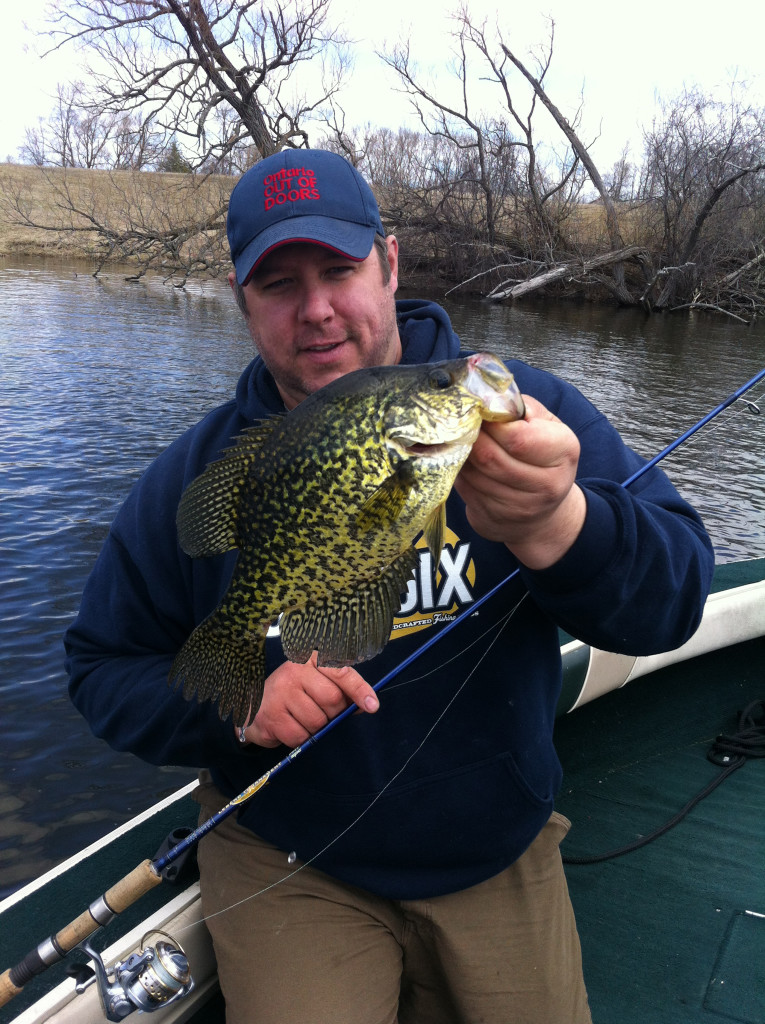 Wood—in any form—will always be a top pick for spring crappie. I really believe that crappie are drawn to types of wood cover based simply on which types are most abundant. Lakes with lots of shallow docks will draw the lion’s share or the fish, if docks are the most abundant feature. If there’s acres of standing timber or stumps, crappies naturally gravitate to these. Most of the lakes I fish are sparsely populated and don’t have a ton of fishable docks and flooded, standing wood is pretty scarce, too. But, there’s tons of laydowns. Some of the biggest pines, cedars and hardwoods take the worst of the wind and winter snow weight and wind up toppling into the water. Most of the downed trees we fish are just massive.
Wood—in any form—will always be a top pick for spring crappie. I really believe that crappie are drawn to types of wood cover based simply on which types are most abundant. Lakes with lots of shallow docks will draw the lion’s share or the fish, if docks are the most abundant feature. If there’s acres of standing timber or stumps, crappies naturally gravitate to these. Most of the lakes I fish are sparsely populated and don’t have a ton of fishable docks and flooded, standing wood is pretty scarce, too. But, there’s tons of laydowns. Some of the biggest pines, cedars and hardwoods take the worst of the wind and winter snow weight and wind up toppling into the water. Most of the downed trees we fish are just massive.
The ‘super’ part of the tree equation not only means huge trees, but also the fact that being so tall and expansive, they’re often flopped out over a huge range of depths, from the shoreline spawning shallows out to much deeper water. This makes them great not only in spring, but all year round. One of the most interesting aspects of these spots is the sheer volume of cover and food for crappie. We find lots of nesting fish near the trunks over soft bottom, pre and post-spawn fish in the mid-sections and off the outer tips, too. It certainly seems likely that crappies in the north do things in waves, like drop eggs, recover and disburse. These big, tangled messes of wood cover fish from the shoreline out into deeper water and really do attract and service crappie in more than one phase of their spring transitions. The deep current game is a lot more fleeting, conditions-dependent and short-lived. Super Trees are one of the most consistent and reliable options we fish. Spawning crappie use them and so do those waiting to move in. So do fish recovering and feeding hard.
Warm weather, steadily rising water temperatures and good weather all around supercharges our tree fishing. They get hotter and hotter as April’s mood swings level out and we start getting in the groove, through May and early June. Under these conditions, food really becomes the big draw. These spots hold huge schools of baby panfish, golden shiners and especially, dace minnows. All three are a shallow water, inshore type of baitfish. They’re right at home in the wood, slop and shorelines. Bait like emerald shiners or smelts live a totally different life. Dace are a smaller baitfish that school tightly and mill around the branches in dense balls, almost like tadpoles. Crappie will push them up into the shorelines and against the tree trunks, gorging. Insect life takes off on wood first. Long before the deep mudflats or amongst the shallow pebbles, trees kick out the year’s first big waves of bugs. Insects hatch here also also fall into the water, from above.
It’s awfully tough to beat small jigs fished under slip bobbers for prodding through the trees. We always honour a crappie’s upward feeding attitude, and rarely set our jigs more than four or five feet deep, even out off the deeper treetops. In tight, a foot or less between bobber and jig is common. Plunk the bobber in, and let the jig settle below it for several seconds. Throw in a jiggle or pop, and let it settle again. Slowly swim it a few feet, and begin the process again. That’s really all there is to it. Look for dark holes, gaps in the branches or anything irregular. Fish your way along the length of each tree, from the shoreline all the way out. You’ll find the fish on the same stuff as you hop from tree to tree, most days. Take your time, be methodical and make accurate little pitches. Bug-looking jig bodies are fantastic for tree fishing. Stubbier profiles in white, brown, black or smoke are just too easy for crappie to swim up to and suck back. They just love plastics. I could comfortably dunk the trees all spring with a Custom Jigs ‘n Spins Shrimpo, Mister Twister Nympth or one inch tube.
Tungsten jigheads really have taken off for all our wood fishing. Being so heavy for their size, they’re compact and get down fast, two big keys for staying out of trouble in the trees. They’re also great for clearer water, or anytime you want to show crappie a small package. Little 10mm Chekais and Marjums from Custom Jigs ‘n Spins have a tiny, needle sharp hook that’s perfect for a Wedgee Tail or a few artificial maggots. Finesse-type rubber like Shrimpos and Wedgees are super sleek and precision cut, with paper thin tails. They never really stop quivering under the bobber. Nothing looks more like crappie food.
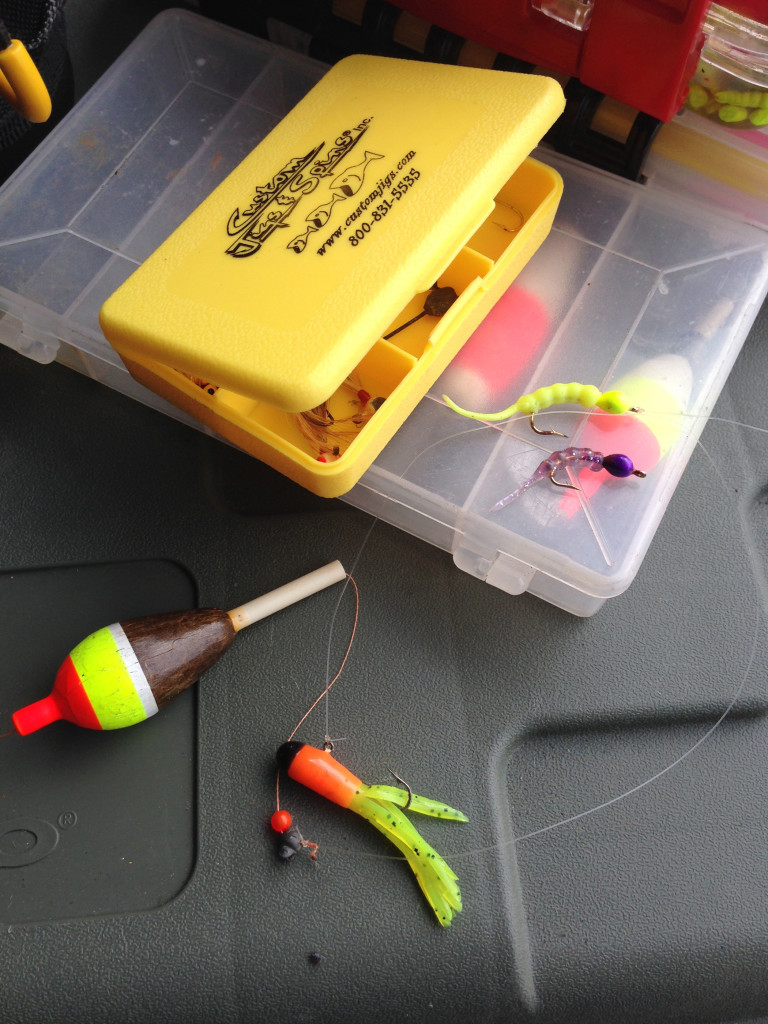
Dead Weeds
Everything you hear or read about spring fishing, for any species, always talks about finding and fishing fresh, crispy weeds. Up north, not only are many of our lakes devoid of classic weed varieties like cabbage or coontail, but any new weed growth available is a long, long way from sprouting in April and May. Most of the weeds we fish early are last fall’s die off. Dead weeds repelling fish is a total myth and in lots of lakes, they offer the season’s first viable cover option for crappie. Not only standing varieties, but old lily pads and rushes. If a crappie can post up on something this time of season in shallow, warmer water, it will.
Large, inshore flats from three to six or seven feet deep hold a ton of old, rotted weeds in early spring. Other than the odd hole or bare patch, there’s really no defined edges or strong features to run, like later in summer. Areas are typically large, and crappies have plenty of room to spread out. We often find this stuff rimming the bottom ends of big bays or tucked in the lee of islands, in shallow water. Gentle bends in river systems are worth checking, too. With lots of ground to cover and plenty of water over the tops of the dead weeds, trolling has become our top method for finding crappies.
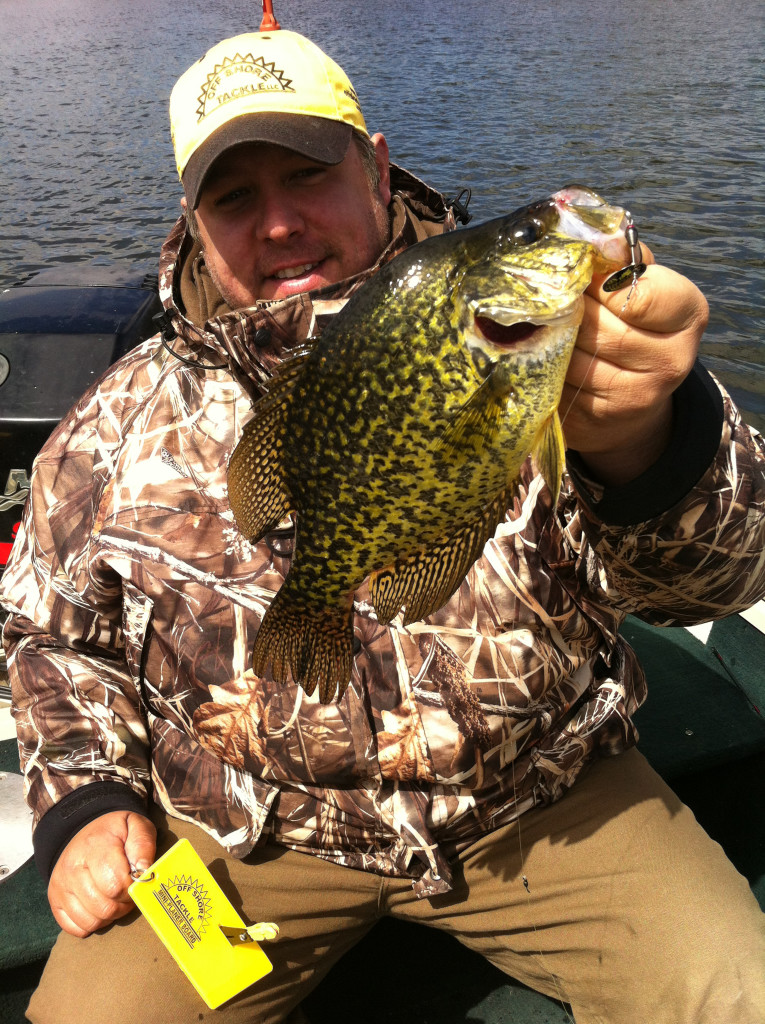 Trolling gets tougher in the shallows as the weeds slowly fill in and stand up, closer to the surface. But right now, most of the cover is flattened down and there’s enough room to run baits over top. If you think trolling’s not a crappie method, I’d urge you to check the leader boards at many of America’s top crappie trail events. From the praries to the south, it’s a killer technique. My buddy Tommy Skarlis wrote the book on trolling for crappies and it spread like wild fire. Flatlining straight behind the boat is nowhere near as productive as spreading lines out to the sides, using small, inline trolling boards. Off Shore Tackle’s Mini Board isn’t much bigger than the average garage door opener, but carries your lures outside the boat’s path. It offers next to no water resistance and can be trolled with any light spinning outfit you’re already jigging or bobber fishing with. Creep-crawling along using your bowmount electric towing a set of ‘boards is perfect for the dead weed flats.
Trolling gets tougher in the shallows as the weeds slowly fill in and stand up, closer to the surface. But right now, most of the cover is flattened down and there’s enough room to run baits over top. If you think trolling’s not a crappie method, I’d urge you to check the leader boards at many of America’s top crappie trail events. From the praries to the south, it’s a killer technique. My buddy Tommy Skarlis wrote the book on trolling for crappies and it spread like wild fire. Flatlining straight behind the boat is nowhere near as productive as spreading lines out to the sides, using small, inline trolling boards. Off Shore Tackle’s Mini Board isn’t much bigger than the average garage door opener, but carries your lures outside the boat’s path. It offers next to no water resistance and can be trolled with any light spinning outfit you’re already jigging or bobber fishing with. Creep-crawling along using your bowmount electric towing a set of ‘boards is perfect for the dead weed flats.
Short leads behind the ‘board, from twenty feet all the way down to four or five, is the way to rig up. Inline spinners and small, floating crankbaits are our two top choices, year after year. Inline spinners get less and less love in fishing media every year, but they’re outstanding crappie lures, believe me. A little, whirring blade ahead of a treble dressed in hair, feathers of plastic is a dead-ringer for any number of insects. Size 00 to 2 spinners are ideal for crappie. There’s no law saying you can’t add in a small chunk or nightcrawler, either. For trolling spinners, use a high-end, ballbearing swivel a foot or so up the line, to minimize line twist. The black-on-black Mepps Xtra Deep in 1/12oz looks as much like a bug as anything in the box.
Of course, small minnow and crankbaits are perfect for running over the old slop, too. Panfish versions of the Reef Runner Ripstick, Rapala Floater or Cordell Big O have all the right moves for crappie in these situations. To this day, one of the biggest northern crappies I ever caught blasted a five inch Husky Jerk over dead weeds while pike fishing many years ago. Applying hard baits over these types of areas was a natural progression for me. Crappie typically crack plugs hard. One of a planer board’s biggest assets is the visual nature of the strike. A twelve or thirteen inch crappie will pin a board hard and it’s awesome to watch. Slip along at 0.5 to 1.5mph and watch for your board to get buried. With lures that sink, like spinners, shorten your leads way up and troll slightly faster. Floating crankbaits can be fished further back and lower speeds keep them running higher. You won’t rip free of dead weeds and keep trolling along. They’re soft and mushy and will foul your baits right away. Setting your running depth to stay out of trouble is key. Weed contact isn’t good, in this case. When you look at the size of these weed flats and how shallow the crappie like to be, planer trolling makes total sense.
And there we have it. Three places we consistently find our spring crappie in Ontario’s northern lakes. The take home message is having a range of spots to suit a wild range of weather conditions. It’s really that simple. Fish what’s most abundant, in terms of cover and always be on the lookout for spots that can host crappie based on fluctuating water levels and temperatures. The tackle really isn’t that complicated. Fish in shallower water are really prone to wild swings in conditions, and at no time is this more common than in the weeks following ice-out. Hopefully, you’ve now got a few new areas on your lakes to try!
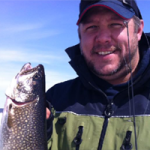 JP Bushey
JP Bushey
JP Bushey is a multi-season, multi-species writer from Barrie, Ontario. Northcentral Ontario’s ‘big water’ is where he spends his time, including Georgian Bay, Lake Nipissing, The French River and The Bay of Quinte. He does speaking engagements, manufactures lures and takes pride in helping people improve their fishing success. You can follow his fishing adventures on Facebook at The Bushey Angle, and on the web at www.thebusheyangle.com


